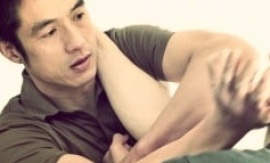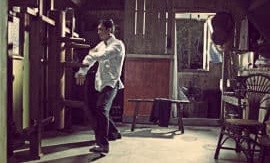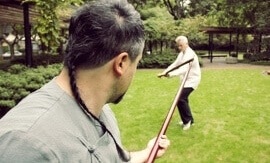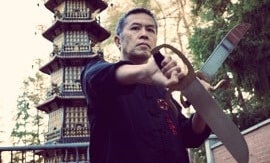
THE HISTORICAL ROOTS OF THE ART OF WING CHUN ARE BELIEVED TO BE SHROUDED IN MYSTERY, BUT THE MORE ONE RESEARCHES THE LEGENDS PASSED DOWN, THE MORE ONE REALISES THESE STORIES HOLD A GREAT DEAL OF ACCURATE INFORMATION.
According to the Kulo tradition, the art of Wing Chun was originally a soft, empty-hand internal boxing system that later made its way to the Red Boat. It was during this time on the Red Boat that the Wing Chun art had an exchange with other southern fist boxing arts. The art of Wing Chun thus adopted the Dummy, Long Pole, Knives and had its first evolution within the empty-hand boxing sets and theory. This is the reason for the different sects of Wing Chun boxing.
The art of Kulo village Pin Sun Wing Chun boxing was developed by Dr. Leung Jan. It is known that when Master Leung retired back to his home village of Kulo, he took on four final pupils. Wong Wah Sam was the Dai Sihing of the final group and gained access to the Gung Fu King via family relations. Wong Wah Sam was Master Leung Jan’s sister’s son! Master Wong Wah Sam taught his uncle’s boxing to eight disciples over a time span of 50 years. Of the eight, there are two still living in Kulo as of 2011. Master Fung Chun, who is 91 years young, and Master Fung Chun’s older brother, Master Fung Men, who is 97!
The teaching of Master Leung during this time period was his own refined fusion of his life’s knowledge of Wing Chun’s Fist, Dummy and Pole skills. The empty hand was taught via the Sup Yi Kuen (Twelve Fists), which is also applied on the Dummy and Pole skills via the Som Dim Boon Gwun (Three & One Half Point Pole).
According to Master Fung Chun, the art of Kulo Wing Chun boxing is largely rooted in the teaching of the Yim family (pre-Red Boat Wing Chun), and Master Leung Jan’s Futshan teaching is largely rooted in Wong Wah Boh’s teaching. The primary difference being the strict adoption of White Crane’s “Square Frontal Facing” to the Wing Chun empty-hand boxing by Wong Wah Boh. This method was passed on by Master Leung Jan in his Futshan Gwoon. Master Leung Jan said this about the difference between schools: “The hands differ very little and both come from the same source!”
Pin Sun Wing Chun’s most basic but truly essential training is the turning Kim Yeung Ma. This turning is also known as Pin Sun Ma (Side Body Horse) and Ding Jee Ma (T-shape Horse). In our art, we typically start and finish every workout session with the turning practice and without a doubt, this will be the first training you are taught in Pin Sun Wing Chun.
Mui Wai Hun Sifu says this about the Kim Yeung Ma practice: “Left, Centre, Right! Those are the basics. Most people are always looking to practice more advanced training but you must train your horse or the later training will not be useful. The horse is the foundation!”
Why is turning so important? It is essential for the conditioning of the body. As the body twist left and right, the hips, shoulders and the spine begin to loosen up so the practitioners develop a greater range of elasticity and relaxation to their body. It is said, that Pin Sun Wing Chun uses a Yau Yun (Soft Waist). This is the result of years of conditioning and not just leaving your hips loose. The turning horse practice works the basic dynamics of the art by training the force vectors (up/down/left/right/forward/backwards) and for combat, the basic turning practice enhances one’s offensive and defensive tactics.
Fung Sang Sifu said this about the Kim Yeung Ma: “When practising in strict Kim Yeung Ma, you sink the waist and drop the shoulders. The buttocks pulls in and knees are a fist distance apart. The bones of the spine must be straight and posture erect. Always maintain the proper three points on a line. This is the correct horse stance!”
The signature set of all Wing Chun boxing is Siu Lin Tau (Small First Training) and it would make sense that Master Leung Jan’s Kulo teaching also begins with the same root. The first two sets of the Twelve Fists are Siu Lin Tau and Dai Lin Tau (Small and Big First Training). What is not commonly known is the second set is actually a nickname and the proper term is “Dai” Siu Lin Tau. So the first two skills of development in Pin Sun boxing are the Siu Lin Tau and then more Siu Lin Tau skills.
Why did Master Leung Jan choose these skills as the foundation of his art? He felt they were the most important aspects of his entire classical set. Some of the actions found within these two simple sets, and its partner exercises, are: Pak (Slap), Tan (Spread), Got (Cut), Jut (Choke), Fook (Subdue), Huen (Circle), Chuen (Thread), Sau (Cover), Wu (Guard), Jing Jeung (Straight Palm), Wahng Jeung (Side Palm), and Som Bai Fut (Three Prayers To Buddha).
Each of the Twelve Fists are extremely core but rich with training and knowledge. Take a look at the list of skills and you will see one common fact: Master Leung Jan’s first two sets focus on Wing Chun’s “open hand” basics. Mui Wai Hun Sifu says this about the Small & Big sets: “They are the ABCs of our art and protect all the important parts of our body— upper and middle gates.”
What we must understand is that the key to success in developing deep understanding, deep coordination, and deep strength with any activity, comes from daily practice and, of course, repetition, repetition, repetition. Master Leung Jan realised this and made sure the Siu Lin Tau and “Dai” Siu Lin Tau would be the right stuff needed for his final group to build a proper foundation.
Master Leung Jan’s Kulo village Pin Sun Wing Chun boxing is an extremely simple, yet profound method of cultivation and application. The basics of the art hit the body in such a powerful way that it is often said that Master Leung’s teaching will develop the practitioner at a rapid pace. A famous Kulo quote states: “Siu Lin Tau & Dai Lin Tau, Practise Often They Will Change You!” What the quote is talking about is the conditioning of the muscles, tendons, sinews and joints with your solo practice. The human body can only move in so many ways and with a solid foundation in the practice of the Master Leung’s basic skills (Kim Yeung Ma, Siu Lin Tau and “Dai” Lin Tau) there is no doubt the art will strengthen and unite the entire body, which is the essential root of Wing Chun as taught by the Gung Fu King.



















